Architecture Home Styles
How Houses Look Like in Europe: A Visual Tour
Journey through the enchanting world of European architecture, where each house unveils a story waiting to be discovered…
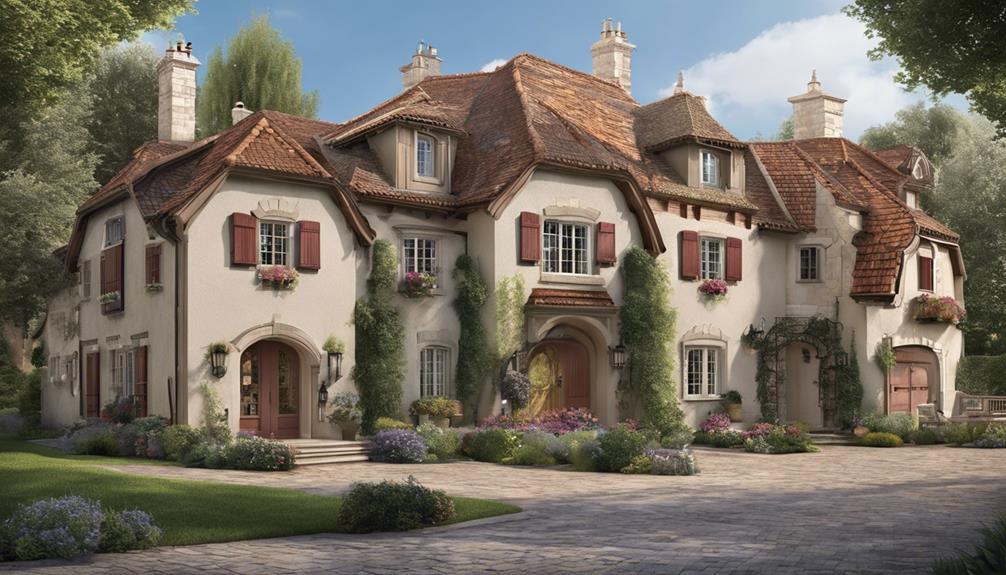
As we stroll through the charming streets of European cities, we can't help but notice the diverse array of architectural styles that grace the landscapes. From the historic cobblestone villages of France to the sleek modern designs of Scandinavia, each house tells a unique story of its own.
But what about the traditional Alpine chalets nestled in Switzerland's snowy peaks or the vibrant townhouses dotting the Spanish countryside? Let's explore the rustic beauty of Italian farmhouses and the intriguing details that make European homes a captivating visual feast for the eyes.
Key Takeaways
- European houses vary from colorful French villages to sleek Scandinavian cities.
- Alpine chalets in Switzerland offer cozy interiors and picturesque mountain views.
- Italian farmhouses feature stone walls, terracotta roofs, and inviting interiors.
- Timber frames, natural light, and cultural influences define Europe's diverse architectural styles.
Historic Charm of French Villages
Exploring the historic charm of French villages reveals a world where stone houses, cobblestone streets, and flower-filled window boxes transport visitors to a bygone era. The stone houses, with their sturdy and timeless appeal, stand proudly along the narrow cobblestone streets, creating a sense of history and continuity. These houses often feature intricate timber frames, adding a touch of rustic elegance to the village scenery. The combination of stone and timber frames gives the buildings a unique character, blending strength and delicacy in a way that only centuries-old architecture can achieve.
Walking through these villages, one can't help but admire the craftsmanship of the colorful shutters and the delicate ironwork details adorning the windows and doors of the houses. Each element tells a story of the past, a tribute to the artisans who shaped these buildings with care and skill. The charming atmosphere of French villages, with their stone houses, cobblestone streets, and timber frames, offers a glimpse into a world where time seems to stand still, inviting us to immerse ourselves in the beauty of the past.
Modern Elegance in Scandinavian Cities

Wandering through the streets of Scandinavian cities unveils a world where modern elegance defines the architectural landscape, showcasing clean lines, minimalist aesthetics, and a focus on functional spaces in every home. The timeless look of Scandinavian houses is achieved through a combination of light, neutral color palettes and the use of natural materials like wood and stone. These design choices not only create a sense of warmth and coziness but also allow for an abundance of natural light to flood the interiors, enhancing the overall ambiance of the living spaces.
In Scandinavian homes, large windows and open floor plans are common features that not only provide a sense of spaciousness but also establish a strong connection to the surrounding nature. Smart technologies and sustainable design elements further contribute to the efficiency of these homes, making them not only aesthetically pleasing but also environmentally friendly. Below is a visual representation of the key elements found in modern Scandinavian house designs:
| Clean Lines | Minimalist Aesthetics | Functional Spaces |
|---|---|---|
| Light, Neutral Color Palette | Natural Materials | Abundance of Natural Light |
Traditional Alpine Chalets in Switzerland
Nestled in the picturesque landscapes of Switzerland, traditional Alpine chalets exude a charming allure with their iconic wooden architecture and distinctive features. These cozy homes offer a glimpse into a world where wood carvings, stone fireplaces, and a warm atmosphere reign supreme.
Key Features of Traditional Alpine Chalets in Switzerland:
- Wooden Elegance: The chalets boast charming wooden architecture with sloped roofs, wide eaves, and intricate wood carvings, creating a rustic yet elegant facade.
- Cozy Interiors: Step inside to find warm wood paneling, stone fireplaces, and rustic furniture that invite you to unwind in a cozy atmosphere, perfect for chilly mountain nights.
- Picturesque Views: Large windows frame breathtaking mountain views, bringing the beauty of the Alps right into the living spaces.
- Charming Details: From decorative balconies to colorful flower boxes, every corner of these chalets is adorned with details that add to their timeless appeal.
Vibrant Townhouses of Spain

Amidst the historic neighborhoods of Spain, the vibrant townhouses stand out with their colorful facades and intricate architectural details. These townhouses often feature stunning tile work, vibrant colors, and ornate balconies that add a touch of charm to the streets. Walking through these neighborhoods, one can admire the blend of traditional features like wooden shutters and wrought iron grilles with modern amenities.
The layout of these townhouses is unique, with living spaces on the lower floors and bedrooms on the upper levels. Many renovated townhouses seamlessly blend historic elements with modern touches, creating a harmonious living space. The concrete floors add a touch of contemporary flair, while the Art Deco influences can be seen in the design details.
One particularly inviting feature of these townhouses is the dining area, where family and friends can gather to enjoy delicious Spanish cuisine. The rooftop terraces offer a serene escape from the bustling streets, providing a perfect spot to relax and take in the beauty of Spanish architecture.
Rustic Beauty of Italian Farmhouses
Exuding a timeless allure with their stone walls, terracotta roofs, and wooden shutters, Italian farmhouses captivate with their rustic beauty and traditional charm. When exploring these picturesque abodes, one can expect to encounter a blend of design elements that showcase the rich history and culture of the Italian countryside.
Here are some key features that make Italian farmhouses truly unique:
- Vineyards and Olive Groves: Surrounding the farmhouse, these natural elements add to the authentic Italian experience.
- Exposed Wooden Beams: Inside, the living room often boasts these rustic beams, adding character and warmth to the space.
- Traditional Tile Flooring: The floors on the second floor are often adorned with traditional tiles that have stood the test of time.
- Cozy Fireplaces: Perfect for chilly evenings, these fireplaces offer a cozy retreat and a touch of old-world charm.
Italian farmhouses not only provide a glimpse into the past but also offer a cozy and inviting atmosphere that celebrates the beauty of rural Italy.
Frequently Asked Questions
What Do Houses in Europe Look Like?
Houses in Europe display a diverse range of styles, from traditional stone cottages to modern architectural wonders. They often feature charming details like colorful shutters, intricate ironwork, and tiled roofs.
Energy efficiency and sustainability are prioritized, seen through features like solar panels and green roofs. Multiple stories and balconies are common to maximize living space. Architectural influences vary, from medieval castles to contemporary designs, reflecting Europe's rich history and diversity.
What Makes a House European Style?
When we think of European-style houses, we envision intricate architectural details like ornate moldings and decorative stonework. These homes often boast charming exteriors with steep roofs and arched windows. Materials like stone, brick, and stucco are commonly used, giving them a classic look.
Inside, luxurious finishes, elegant furnishings, and grand features such as staircases and fireplaces contribute to their sophisticated ambiance. European-style homes exude timeless elegance and charm.
What Is the Difference Between American and European Houses?
When comparing American and European houses, we notice distinct differences. European houses often prioritize historic charm and intricate architectural details, while American homes typically focus on modern amenities and larger square footage.
European houses tend to be smaller but emphasize efficient use of space and quality craftsmanship. Unique features like exposed beams and ornate facades are common in European architecture, which also often blends with the surrounding landscape and historical context.
What Is a Tour House?
A tour house is a luxurious property that offers a unique experience for guests. It isn't just a place to stay; it's a sanctuary where relaxation and indulgence meet.
With spacious rooms, stunning views, and top-notch amenities, a tour house goes beyond a typical vacation rental. It's a haven where memories are made and cherished for a lifetime.
Conclusion
As we journeyed through the diverse landscapes of Europe, we were captivated by the historic charm of French villages, the modern elegance of Scandinavian cities, the traditional Alpine chalets in Switzerland, the vibrant townhouses of Spain, and the rustic beauty of Italian farmhouses.
Each home we explored was a masterpiece in its own right, showcasing the unique culture and design aesthetic of its region. Our visual tour left us in awe of the architectural wonders that Europe has to offer.
- About the Author
- Latest Posts
Introducing Ron, the home decor aficionado at ByRetreat, whose passion for creating beautiful and inviting spaces is at the heart of his work. With his deep knowledge of home decor and his innate sense of style, Ron brings a wealth of expertise and a keen eye for detail to the ByRetreat team.
Ron’s love for home decor goes beyond aesthetics; he understands that our surroundings play a significant role in our overall well-being and productivity. With this in mind, Ron is dedicated to transforming remote workspaces into havens of comfort, functionality, and beauty.
Architecture Home Styles
Why People Do Enjoy Gothic Literature Explained
Bask in the enigmatic allure of Gothic literature as we unravel the secrets behind its enduring fascination, beckoning you to explore further.

As we navigate the shadowy corridors of Gothic literature, we are drawn to its enigmatic allure like moths to a flickering flame. The genre's ability to unearth the depths of human nature and confront the darkest corners of the mind beckons us to explore further.
However, what truly captivates us lies beneath the surface, hidden within the intricate tapestry of themes and emotions waiting to be unraveled. Join us as we uncover the secrets behind the enduring fascination with Gothic literature and unravel the mysteries that lie within its pages.
Key Takeaways
- Gothic literature captivates with dark settings and mysterious elements, creating suspense and unease.
- Characters delve into hidden desires and darker traits, reflecting psychological exploration.
- Exploration of mortality, decay, and forbidden desires prompts contemplation and catharsis.
- Thrilling suspense and impending doom keep readers engaged, adding an eerie charm to Gothic literature.
The Allure of Dark and Mysterious Settings
Dark and mysterious settings in Gothic literature captivate readers with their ominous charm, immersing them in a world of foreboding and intrigue. Gothic fiction often employs haunted houses, ancient castles, and remote locations shrouded in mystery to create an atmosphere of horror and suspense. These Gothic elements enhance the sense of unease and tension, drawing readers into the eerie and gloomy environments that permeate the narrative.
The allure of these dark and mysterious settings lies in their ability to evoke a haunting beauty that appeals to our fascination with the macabre. The gothic aesthetics present in these settings contribute to the genre's atmospheric storytelling experience, enveloping readers in a world where the line between reality and the supernatural is blurred.
Psychological Depth of Characters

Exploring the intricate inner worlds of characters in Gothic literature reveals a fascinating tapestry of psychological depth, shedding light on their hidden desires, inner conflicts, and haunting past experiences.
Within the realm of Gothic literature, characters often embody a myriad of psychological traits that unveil the darker aspects of human nature. These characters grapple with inner conflicts that stem from guilt, obsession, and madness, offering a profound exploration of the complexities of the human psyche.
The psychological depth of these characters serves to create a chilling sense of unease and suspense, drawing readers into their twisted perceptions and vulnerabilities. Through their fears and distorted realities, Gothic protagonists mirror the inner turmoil that lurks within all individuals, highlighting the impact of past traumas on present actions.
Gothic literature, with its focus on the psychological intricacies of characters, provides a compelling lens through which to examine the profound depths of human nature and the haunting manifestations of the mind.
Themes of Death and Decay
Themes of death and decay permeate Gothic literature, delving into the macabre and morbid aspects of existence with a haunting intensity. In this genre, the exploration of mortality and decay serves as a powerful tool to evoke a range of emotions and provoke deep contemplation. Here's why this theme is crucial:
- Symbolism of Decay: Gothic horror often uses decay as a symbol of the inevitable nature of death, highlighting the transient quality of life.
- Human Fear and Curiosity: The fascination with mortality and decay in Gothic works reflects a profound human fear and curiosity about the unknown.
- Psychological Deterioration: Characters in Gothic literature frequently encounter physical decay in their surroundings, mirroring their own psychological deterioration.
- Contemplation of Existence: By confronting the theme of death and decay, Gothic narratives prompt readers to ponder the fragility of existence and the mysteries of mortality.
Through these elements, Gothic literature creates a chilling atmosphere that captivates audiences and delves into the darker aspects of human experience.
Exploration of Forbidden Desires
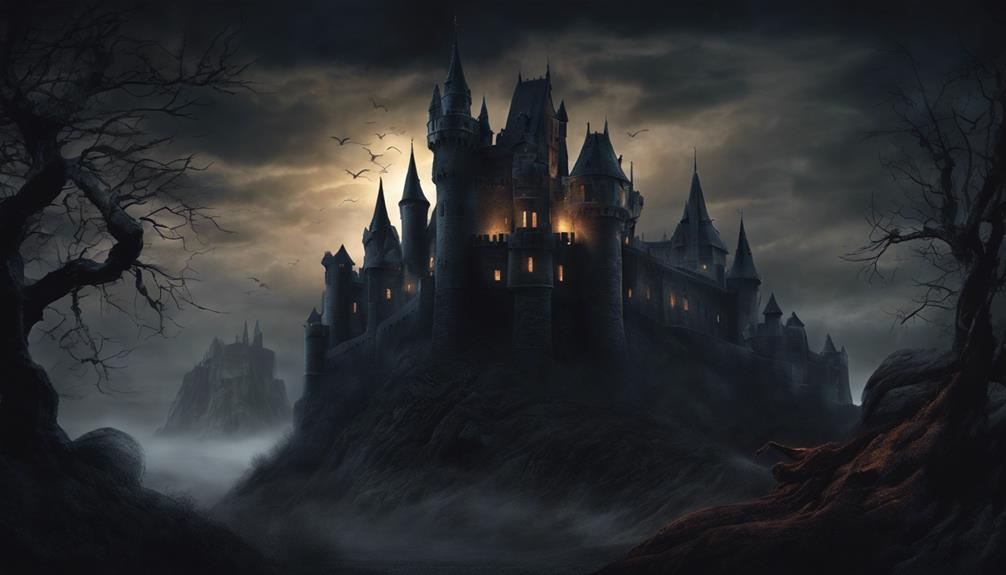
When delving into Gothic literature, one encounters a profound exploration of taboo subjects and forbidden desires that illuminate the darker recesses of human nature.
Gothic literature serves as a vehicle for diving into the forbidden aspects of human desires, those typically suppressed or shunned by societal norms.
Through this genre, readers are offered a safe space to confront these hidden desires, allowing for a cathartic experience that can be both enlightening and liberating.
Sense of Impending Doom and Suspense
The exploration of forbidden desires in Gothic literature seamlessly transitions into a haunting portrayal of impending doom and suspense, intensifying the psychological grip on readers' emotions.
The sense of impending doom in horror stories creates tension and suspense, keeping readers engaged with a thrilling element that heightens their emotional investment in the narrative.
Gothic tales often feature ominous foreshadowing and eerie atmospheres, enhancing the feeling of impending dread and setting a tone of unease.
The anticipation of a looming threat or catastrophe adds a thrilling element to Gothic narratives, captivating readers with an unsettling sense of anticipation.
This theme taps into primal fears, drawing readers into a suspenseful build-up that amplifies the eerie atmosphere and keeps them on the edge of their seats.
The intertwining of impending doom and suspense in Gothic literature contributes to its enduring appeal, offering a rich tapestry of emotions and experiences for those seeking liberation through thrilling storytelling.
Frequently Asked Questions
Why Do People Enjoy Gothic Literature?
We enjoy Gothic literature for its ability to delve into deep fears and societal critiques. The genre's exploration of mortality, darkness, and the supernatural captivates us, offering a unique blend of psychological depth and eerie atmospheres.
Gothic narratives resonate with universal human experiences, drawing readers in with mystery, suspense, and complex character dynamics. Through taboo topics and immersive storytelling, Gothic literature provides a safe space to confront the unknown and embrace the macabre.
How Does Gothic Literature Make You Feel?
Gothic literature envelops us in a chilling embrace, stirring a mix of dread and fascination. The eerie settings and dark themes tap into our deepest emotions, leaving us unsettled yet captivated.
Characters, flawed and intricate, resonate with our own complexities, drawing us into their twisted world. It's a journey through the macabre, a dance with the unknown that both terrifies and enthralls us, offering a cathartic release for our hidden fears and desires.
How Does Gothic Literature Affect People?
Gothic literature affects us by stirring emotions of fear, suspense, and unease through its dark and eerie settings. It engages our minds with themes of death, decay, and the supernatural, crafting a sense of mystery and intrigue.
Psychologically, it offers a cathartic journey to confront inner fears and anxieties in a secure environment. The genre reflects societal concerns, providing a platform to critique conventional values and express Romantic ideals in a somber, atmospheric backdrop.
What Is the Obsession of Gothic Novels?
The obsession with Gothic novels is multifaceted. Readers are drawn to the dark themes, mysterious atmospheres, and psychological depths explored within these works.
Elements like haunted houses, supernatural occurrences, and eerie settings create suspense and intrigue, captivating audiences. Gothic literature provides a safe space to confront fears, desires, and societal anxieties in a controlled, fictional setting.
Its timeless themes of death, decay, romance, and the supernatural continue to resonate with readers, transcending generations.
Conclusion
In conclusion, the enduring appeal of Gothic literature lies in its ability to delve into the depths of human emotions and fears, providing a cathartic experience for readers.
While some may argue that the genre's dark themes can be unsettling, it's through confronting these taboo topics that we're able to gain a deeper understanding of ourselves and the world around us.
Gothic literature serves as a mirror reflecting our innermost desires, fears, and complexities, making it a truly timeless and captivating genre.
- About the Author
- Latest Posts
Introducing Ron, the home decor aficionado at ByRetreat, whose passion for creating beautiful and inviting spaces is at the heart of his work. With his deep knowledge of home decor and his innate sense of style, Ron brings a wealth of expertise and a keen eye for detail to the ByRetreat team.
Ron’s love for home decor goes beyond aesthetics; he understands that our surroundings play a significant role in our overall well-being and productivity. With this in mind, Ron is dedicated to transforming remote workspaces into havens of comfort, functionality, and beauty.
Architecture Home Styles
What Are the Three Principles of Wabi-Sabi?
Fathom the essence of Wabi-Sabi through its three principles, as we delve into the beauty of imperfection and simplicity.
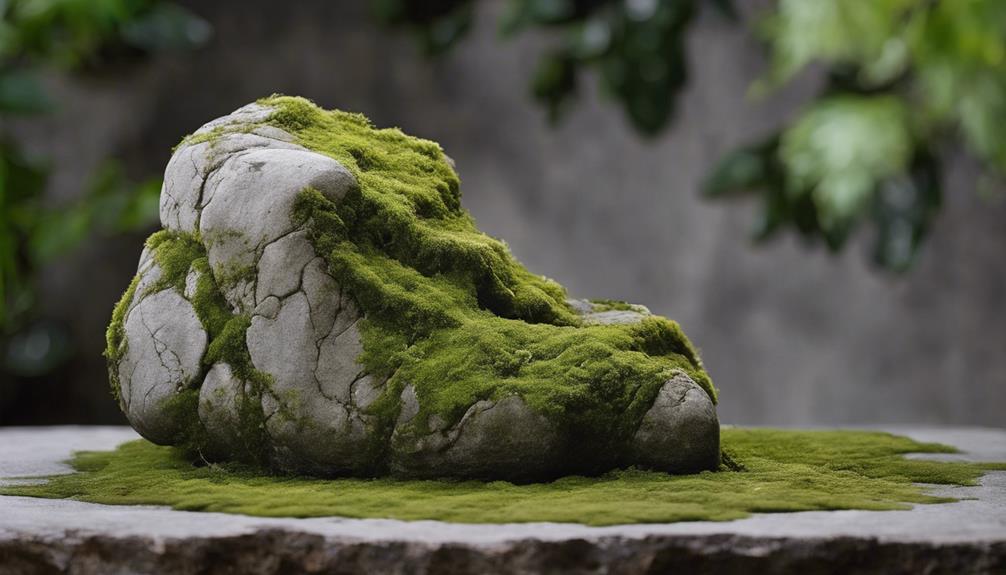
When exploring the essence of Wabi-Sabi, we uncover a profound philosophy that resonates with the beauty of imperfection and transience.
The three principles lie at the core of this Japanese worldview, guiding us to appreciate the elegance found in simplicity, imperfection, and the natural cycles of life.
As we embark on this journey to grasp the depth of Wabi-Sabi, we are drawn into a realm where authenticity and acceptance intertwine, inviting us to see the world through a new lens.
Key Takeaways
- Wabi-Sabi celebrates imperfection and impermanence in beauty.
- Yūgen emphasizes hidden beauty and profound emotions.
- Authenticity and acceptance are intertwined in Wabi-Sabi philosophy.
- Heightened awareness in Wabi-Sabi fosters connection and introspection.
Sabi: Beauty of Aging and Wear
Celebrating the beauty of aging, patina, and wear, Sabi in Wabi-Sabi embodies the elegance and character that evolves with the passage of time. In the realm of Wabi-Sabi philosophy, Sabi plays a pivotal role in acknowledging three simple realities: nothing lasts, nothing is finished, and nothing is perfect. This concept finds its roots in ancient Japanese aesthetics, where impermanence and imperfection aren't only accepted but revered. Sabi finds beauty in imperfection, encapsulating the essence of objects that bear the marks of time.
In the context of Sabi, one can observe the allure of objects such as gold lacquer or broken pottery, where the wear and tear over time add a layer of depth and richness to their appearance. The patina that develops on surfaces or the cracks in pottery aren't seen as flaws but rather as testaments to the journey these objects have undergone. Embracing Sabi allows individuals to appreciate the beauty that emerges from the natural progression of time, fostering a profound connection to the ever-changing world around us.
Wabi: Beauty of Simplicity and Austerity
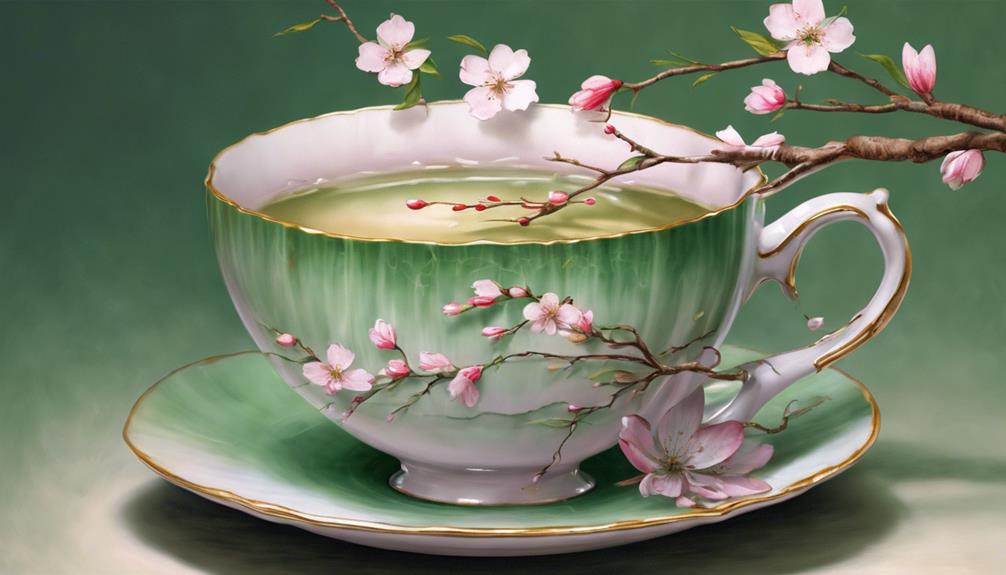
Rooted in the core principles of Wabi-Sabi, the concept of Wabi embodies a profound appreciation for the beauty derived from simplicity and austerity, reflecting a deep connection to the essence of natural existence. In Japanese art and the tea ceremony, Wabi captures the elegance found in minimalism, imperfection, and the unembellished beauty of the everyday.
It celebrates the beauty that arises from embracing impermanence and the transient nature of life, encouraging individuals to find tranquility in the ever-changing world. Embracing austerity, Wabi emphasizes the importance of humility and understated elegance, fostering a deep connection to nature and mindfulness in one's surroundings.
Yūgen: Beauty of the Subtle and Profound
Emphasizing the profound beauty found in subtle and hidden experiences, Yūgen encapsulates a deep appreciation for the mysterious elements that evoke profound emotions. In the realm of Japanese culture and aesthetics, Yūgen within Wabi-Sabi goes beyond surface-level beauty, urging individuals to delve into the enigmatic and subtle aspects of existence. It invites contemplation and reflection on the intrinsic beauty that lies within the ordinary and everyday moments, elevating them to a level of profound significance.
Yūgen challenges individuals to embrace the unknown and engage their imagination to perceive the hidden depths of beauty that surround them. By fostering a sense of wonder and reverence for the subtle nuances of life, Yūgen encourages a deeper connection with emotions and experiences that transcend the mundane.
Through Yūgen, Wabi-Sabi guides individuals towards a heightened awareness of the profound beauty that exists in quiet contemplation and introspection, inviting them to find solace and inspiration in the subtle and profound aspects of the world around them.
Frequently Asked Questions
What Are the Principles of Wabi-Sabi?
We appreciate the inquiry into the principles of wabi-sabi, a philosophy celebrating imperfection, impermanence, and incompleteness. These principles guide us to find beauty in the natural cycle of life, embracing flaws as part of existence.
What Are the Elements of Wabi-Sabi?
Appreciating imperfections, simplicity, and asymmetry defines Wabi-Sabi. It celebrates the beauty in nature's flaws. This philosophy values intimacy, roughness, and economy in design. Wabi-Sabi principles embrace impermanence, rooted in Buddhist teachings, shaping Japanese art.
What Are the 5 Teachings of Wabi-Sabi?
In our exploration of wabi-sabi, we uncovered not three but five teachings: impermanence, imperfection, incompleteness, beauty in the overlooked, and coaxing beauty from ugliness. These principles enrich our understanding of life's essence.
What Is the Wabi-Sabi Rule?
We see beauty in imperfection, the fleeting nature of life, and the incomplete. Wabi-Sabi teaches us to embrace these truths, finding joy in unexpected places. Its essence lies in simplicity, imperfection, and the dynamic beauty of impermanence.
Conclusion
In conclusion, the three principles of Wabi-Sabi offer a profound perspective on beauty, imperfection, and authenticity.
Like a weathered stone, Wabi-Sabi teaches us to appreciate the beauty in imperfection and impermanence, guiding us towards a deeper understanding of ourselves and the world around us.
By embracing natural materials, imperfections, and giving ourselves a break, we can find true beauty in the simplicity and authenticity of life.
- About the Author
- Latest Posts
Introducing Ron, the home decor aficionado at ByRetreat, whose passion for creating beautiful and inviting spaces is at the heart of his work. With his deep knowledge of home decor and his innate sense of style, Ron brings a wealth of expertise and a keen eye for detail to the ByRetreat team.
Ron’s love for home decor goes beyond aesthetics; he understands that our surroundings play a significant role in our overall well-being and productivity. With this in mind, Ron is dedicated to transforming remote workspaces into havens of comfort, functionality, and beauty.
Architecture Home Styles
Top 3 Must-Have Features in a Tropical House
Keen on discovering the often-overlooked factor that could revolutionize your tropical living experience? Find out in this insightful exploration of essential features for a tropical house.
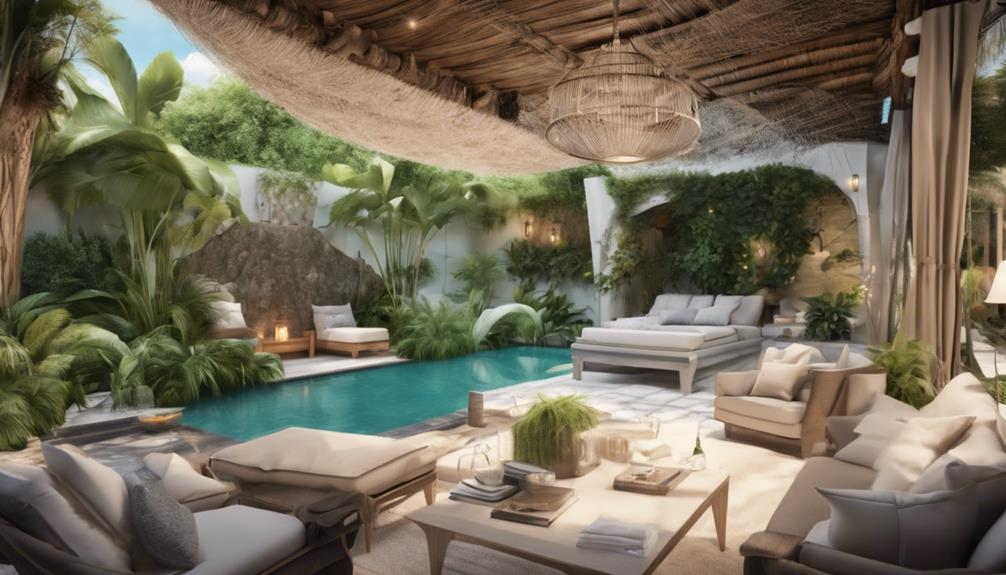
When considering the essential elements of a tropical house, one cannot underestimate the significance of site orientation and design, shading strategies, and ventilation. These features play a pivotal role in optimizing comfort and sustainability in a tropical climate.
However, there is a crucial factor that often goes overlooked but is equally essential to creating a harmonious living environment in such regions. By exploring this often-neglected aspect, we can truly enhance the tropical living experience.
Key Takeaways
- Cross ventilation and louvre windows optimize airflow and cooling in tropical homes.
- Seamless indoor-outdoor connectivity enhances living spaces and promotes a connection with nature.
- Sustainable building materials like rammed earth and local sourcing support eco-friendly living.
- Effective shading strategies, such as external devices and vegetation, control heat gain for comfort.
Natural Ventilation Systems
Enhancing airflow through carefully positioned openings in a tropical home not only reduces the need for mechanical cooling but also creates a refreshing indoor environment.
In our quest for innovative natural ventilation systems, we've found that cross ventilation is key. By strategically placing louvre windows and casement windows across from each other, we capitalize on air movement, allowing for a continuous flow throughout the living spaces. These materials used in the windows aren't only functional but also add a touch of elegance to the tropical home.
Open windows play a crucial role in promoting the circulation of fresh air, contributing to better indoor air quality and overall comfort. Embracing the concept of stack effect further enhances this natural cooling process. Warm air effortlessly rises and exits through high openings, drawing in cooler air from lower ones.
This harmonious dance of air movement not only cools but also invigorates the tropical home, making it a sanctuary of relaxation and well-being.
Outdoor Living Spaces
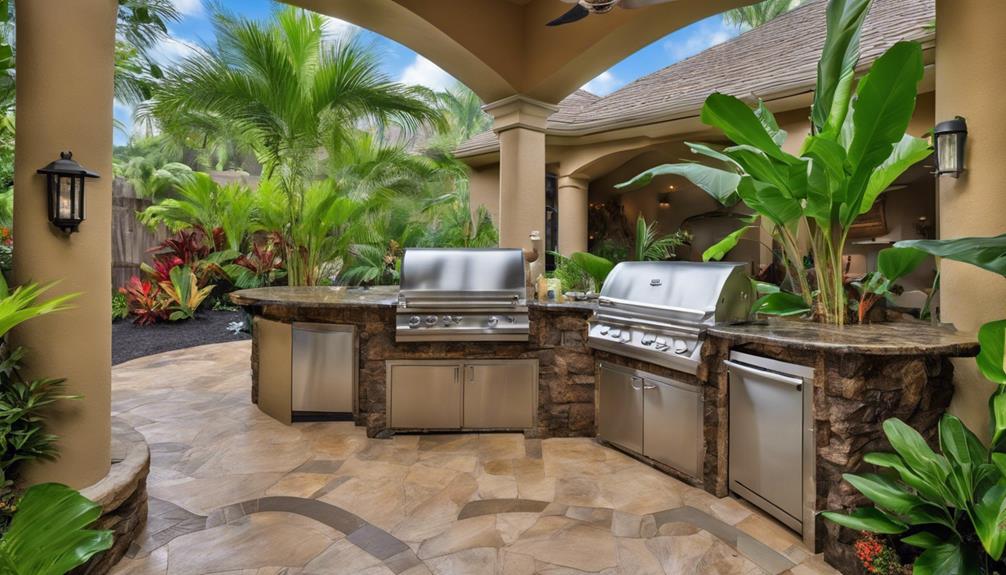
In creating tropical houses, the seamless transition from indoor living spaces to outdoor areas is essential for fostering a harmonious connection with nature. Designing outdoor living spaces is a good idea as it allows for a closer interaction with the tropical environment while providing a relaxing retreat. Including features like a front porch, strategically placed windows and doors, and considering air conditioning options can enhance the overall experience of these outdoor areas.
| Feature | Description | Benefits |
|---|---|---|
| Front Porch | Welcoming entry area with seating | Extends living space, promotes socializing |
| Windows and Doors | Large, openable windows for natural light | Improves ventilation, connects indoors to out |
| Air Conditioning | Optional cooling for extremely hot days | Ensures comfort, allows for use year-round |
These elements not only add aesthetic value but also create functional spaces that blend seamlessly with the tropical surroundings, making outdoor living an integral part of the tropical house experience.
Sustainable Materials
Utilizing sustainable materials in tropical house construction enhances environmental consciousness while promoting durability and energy efficiency. When considering sustainable materials for a tropical house north of the equator, it's crucial to select options that not only minimize environmental impact but also offer practical benefits throughout the year.
- Natural Insulation: Materials like rammed earth, straw bales, and adobe provide excellent insulation properties, keeping the interior of the house cool on hot days and warm on cooler nights.
- Local Sourcing: Opting for locally sourced materials reduces transportation emissions and supports the local economy, making it a sustainable choice for tropical regions.
- Energy Efficiency: Incorporating eco-friendly materials such as cork, hempcrete, and recycled glass can significantly contribute to energy efficiency, reducing the overall carbon footprint of the house.
- Indoor Air Quality: Sustainable materials contribute to better indoor air quality, creating a healthier living environment on every side of the house.
Frequently Asked Questions
What Are the Features of a Tropical House?
When we think about the features of a tropical house, we envision a design that embraces nature with large windows for light, high ceilings for air circulation, and natural materials for sustainability.
The integration of outdoor spaces like verandas and gardens further connects us to the environment. It's all about creating a harmonious blend of indoor and outdoor living, ensuring comfort and tranquility in a tropical setting.
What Is the Best House Design for a Hot Humid Climate?
In a hot humid climate, our ideal house design focuses on natural ventilation and sun protection.
We prioritize effective shading strategies like horizontal shading for north and south walls and vertical shading for east and west walls.
Lightweight wall materials are key for insulation and durability. Roof design with reflective materials and overhangs minimizes heat gain.
Outdoor spaces like patios create shaded connections to the natural environment for a comfortable tropical living experience.
How Do You Build a Cool House in the Tropics?
When building a cool house in the tropics, we focus on natural ventilation, smart shading strategies, and lightweight materials. These elements help maintain thermal comfort and resist harsh tropical conditions.
What Is Tropical Style House?
Tropical style houses are like nature's hug wrapped in architectural wonder. They blend open spaces, abundant light, and smart ventilation to create a sanctuary in the midst of tropical heat.
These homes boast designs that dance with the elements, featuring overhangs, verandas, and durable materials that defy the sun and rain. Living in a tropical house is like being cradled by the environment itself, a harmonious blend of comfort and sustainability.
Conclusion
In conclusion, designing a tropical house with natural ventilation systems, outdoor living spaces, and sustainable materials is like creating a vibrant oasis in the midst of a sweltering jungle.
By harnessing the power of the elements and embracing eco-friendly practices, we can craft a sanctuary that not only protects us from the heat but also connects us with the beauty of our surroundings.
Let's build homes that breathe life into our tropical paradise.
- About the Author
- Latest Posts
Introducing Ron, the home decor aficionado at ByRetreat, whose passion for creating beautiful and inviting spaces is at the heart of his work. With his deep knowledge of home decor and his innate sense of style, Ron brings a wealth of expertise and a keen eye for detail to the ByRetreat team.
Ron’s love for home decor goes beyond aesthetics; he understands that our surroundings play a significant role in our overall well-being and productivity. With this in mind, Ron is dedicated to transforming remote workspaces into havens of comfort, functionality, and beauty.
-

 Vetted2 days ago
Vetted2 days ago15 Best Smelling Floor Cleaners That Will Leave Your Home Fresh and Inviting
-

 Vetted3 weeks ago
Vetted3 weeks agoBest Mop for Sparkling Clean Floors in 2024
-

 Vetted2 days ago
Vetted2 days agoBest Space Heater for Your Home in 2024
-
![Best Bath Towels for a Luxurious Bathroom Experience [2024] 145 91pzOy780zL](https://byretreat.com/wp-content/uploads/2023/11/91pzOy780zL-400x240.jpg)
![Best Bath Towels for a Luxurious Bathroom Experience [2024] 146 91pzOy780zL](https://byretreat.com/wp-content/uploads/2023/11/91pzOy780zL-80x80.jpg) Vetted2 days ago
Vetted2 days agoBest Bath Towels for a Luxurious Bathroom Experience [2024]
-

 Vetted2 days ago
Vetted2 days agoBest Electric Mower of 2024: Top Picks for a Perfectly Manicured Lawn
-

 Vetted1 day ago
Vetted1 day agoBest Riding Mower: Top 10 Picks for 2024
-
![Best Mouse Trap: Top 10 Traps for Effective Rodent Control [2024] 151 71qaRXm6raL 1](https://byretreat.com/wp-content/uploads/2023/11/71qaRXm6raL-1-400x240.jpg)
![Best Mouse Trap: Top 10 Traps for Effective Rodent Control [2024] 152 71qaRXm6raL 1](https://byretreat.com/wp-content/uploads/2023/11/71qaRXm6raL-1-80x80.jpg) Vetted2 hours ago
Vetted2 hours agoBest Mouse Trap: Top 10 Traps for Effective Rodent Control [2024]
-

 Vetted1 day ago
Vetted1 day agoBest Adult Games of 2024
























![Best Fans for Bedroom: Top Picks for a Cool and Comfortable Sleep [2024] 137 71JH6qv1EKL](https://byretreat.com/wp-content/uploads/2023/11/71JH6qv1EKL-80x80.jpg)
